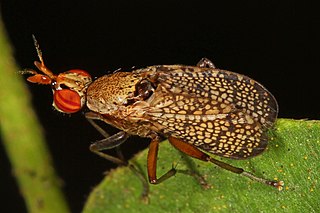
The Anthomyiidae are a large and diverse family of Muscoidea flies. Most look rather like small houseflies, but are commonly drab grey. The genus Anthomyia, in contrast, is generally conspicuously patterned in black-and-white or black-and-silvery-grey. Most are difficult to identify, apart from a few groups such as the kelp flies that are conspicuous on beaches.

The Chamaemyiidae are a small family of acalyptrate flies with less than 200 species described worldwide. The larvae of these small flies are active and predatory and are often used for biological control of aphids, scale insects, and similar pests. Chamaemyiid fossils are poorly represented in amber deposits, but a few examples are known from the Eocene epoch onwards.

The Coelopidae or kelp flies are a family of Acalyptratae flies, they are sometimes also called seaweed flies, though both terms are used for a number of seashore Diptera. Fewer than 40 species occur worldwide. The family is found in temperate areas, with species occurring in the southern Afrotropical, Holarctic, and Australasian regions.

Phaonia is a very large genus from the fly family Muscidae. It is distributed worldwide, with more than 750 species having been identified.

Chironomini is a tribe of midges in the non-biting midge family (Chironomidae).

Ceromya is a genus of tachinid flies in the family Tachinidae, containing the following species:

The Helcomyzidae are a small family of flies in the Acalyptratae. The larvae feed on kelp and other organic matter washed up on shorelines. Species diversity is highest in New Zealand and south temperate South America. They are sometimes allied with the families Dryomyzidae or Coelopidae.

Pherbellia is a genus of flies in the family Sciomyzidae, the marsh flies or snail-killing flies. They occur throughout the world, except for the Subantarctic region.

Crumomyia is a genus of flies belonging to the family lesser dung flies (Sphaeroceridae).

Tetanocerini is a tribe of flies in the family Sciomyzidae. There are at least 120 described species in the tribe.
Coelopa is a genus of kelp flies in the family Coelopidae. There are about 14 described species in Coelopa.

Sciomyzinae is a subfamily of flies in the family Sciomyzidae.
Dasycoelopa is a genus of kelp flies in the family Coelopidae.
Coelopina is a genus of kelp flies in the family Coelopidae.
Chaetocoelopa is a genus of kelp flies in the family Coelopidae.
Beaopterus is a genus of kelp fly in the family Coelopidae.
Coelopella is a genus of kelp flies in the family Coelopidae.
Glumini is a tribe of kelp flies in the family Coelopidae.
Coelopellini is a tribe of kelp flies in the family Coelopidae.
Coelopinae is a subfamily of kelp flies in the family Coelopidae.










